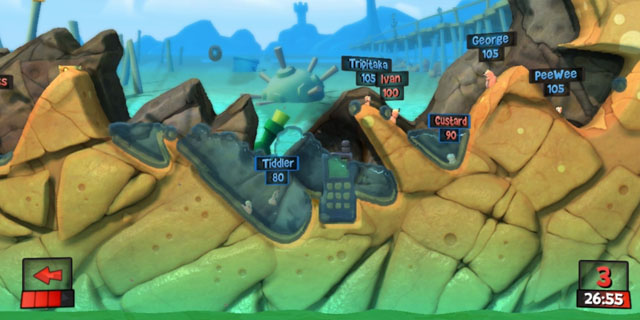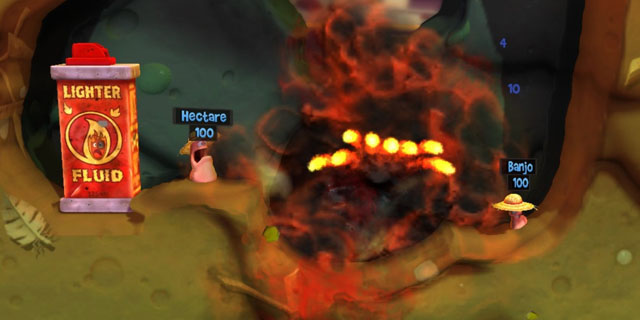
Turn-based mechanics make combat more about strategy than reflex. This simple truth is why I prefer Final Fantasy X to XII and what makes Hero Academy and XCOM: Enemy Unknown so much fun. For those unfamiliar with the series, Worms is absolutely off-the-rails crazy. It’s a game about war-mongering annelids using teleports, bazookas, ninja ropes, dragon punches, and much more to straight-up murder every other invertebrate on the opposing team.
Matches are, as I mentioned, turn-based. Side one moves, fires, destroys, etc. and then waits around and watches his opponent do the same. You can set up traps that are activated on the enemy’s turn and try to hide your worms at the end of a round to protect them from harm, but the creative opponent will simply whip out a bazooka and blow a hole in the ceiling (letting a whole bunch of water in) and then laugh maniacally as your last worm drowns and takes damage (or, if you’re really unlucky and air-headed enough to park your worm on a slope, falls into the sea and is instantly killed).
Aside from the gruesome water-related death that sounds like every other 2D Worms game that’s been released. What sets this one apart? Well, the water is fun, and it brings with it some new items like the water pistol for creating waterslides on the fly, the drain plug for preventing a combatant’s watery demise, and the water strike which is a lot like the air strike except you’re using water balloons instead of bombs.

The water flows as you’d expect water to do, and drowns worms just like it should because it’s water, the worm is under all of it, and it needs air to live. There are other physics objects introduced that create environmental hazards like lighters and glass flasks, that can be moved with telekinesis and dropped on enemies or shot at in the hopes that they will explode or release gas and score some points for your team.
The biggest difference from previous titles, and a system that I like quite a bit, is that there are different classes of worms with different strengths and weaknesses. It’s not just your all-around squad versus your opponent’s all-around squad. I’m setting up traps with my Scientist because he gets a bonus for doing brainy things and hits like a little baby. I’m running all over creation with my Scout because he’s small enough to fit in tight spaces and he’s fast. I’m using the Soldier to do whatever else needs doing because he’s your basic all-around unit, and I’m not using the Heavy at all even though he can take a pounding, because he is torturously slow and can’t jump for beans. Heavies are okay if you can teleport them into a good place, but if you’re walking to your opponent, forget it. He can soak up damage, but he needs to because it takes him three times as long to get anyplace worth going.
There is a campaign with 32 levels, and it gets fairly challenging. Worms Revolution’s legs, though, are most definitely in its multiplayer. Fun and destructible battlefields, over-the-top weapons and drowning your opponent’s pesky worms is great fun, and the level to which players can customize versus matches is amazing. You have full control over what weapons show up, when they show up, whether worms take fall damage, percentage chance that an item will show up, how long fuses are on explosives, whether some explosive mines are duds and plenty of other things. If default multiplayer isn’t the experience you want, you can tailor it until it is. And if you don’t like the classes, you can play classic multiplayer instead of deathmatch. That’s the only difference between the two. The amount of customization is astounding, and the replay value is high thanks to the very fun multiplayer.
Pros: Lengthy single-player campaign, very customizable multiplayer, drowning enemy worms is great fun
Cons: All of the worms except the Scout move slower than I’d like, physics objects take longer than they should to blow up and affect the battlefield



















